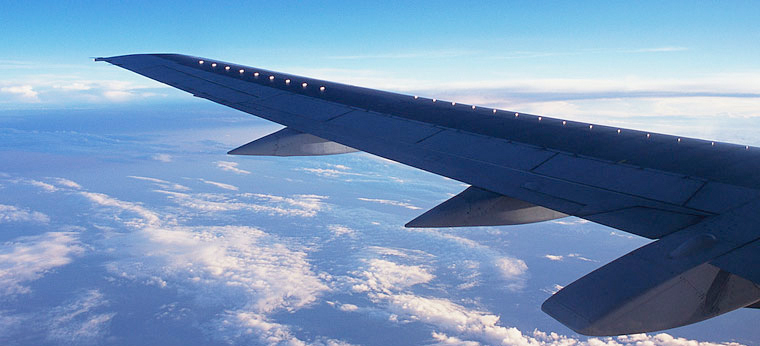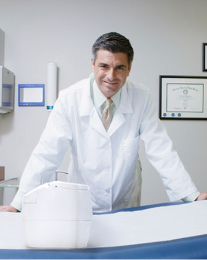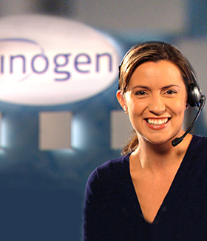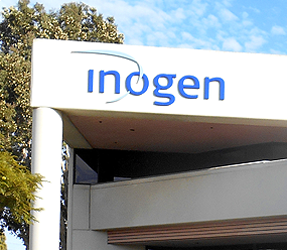UPDATED MARCH 2023
Before considering air travel, talk to your doctor to make sure that your lungs are healthy enough for flying and ask about how to manage air travel with oxygen therapy. The lower air pressure and lower than normal oxygen levels that come with increased altitude can cause the expansion of gasses in your body, which is what causes your ears to pop during take-off. For people with lung disease, this combination of lower oxygen levels and air pressure can be problematic. [1]
So you may be wondering, “Can I bring oxygen on a plane?” The answer is yes, you can travel with an FAA-compliant portable oxygen concentrator (POC) on an airplane! [1] Inogen portable oxygen concentrators meet FAA acceptance criteria for POCs used onboard aircraft*. Read on to learn more about air travel with oxygen therapy products.

Supplemental Oxygen on Airplanes
If you have wondered, “Can you take oxygen on an airplane?” the answer is: it depends on the kind of oxygen you use. Airline travel used to be a hassle for people who require medical oxygen. Compressed oxygen and liquid oxygen tanks are not allowed on airplanes, [2] so flying often meant arranging for delivery of oxygen supplies at your destination. And, of course, if the flight was too long to be managed without oxygen, the person was simply unable to fly. This made traveling with oxygen either completely impossible or much more cumbersome, and the oxygen-airplane conundrum was frustrating for those with on-the-go lifestyles and travel needs.
Inogen saw a need for better technology—more compact, more convenient—that could keep pace with the active lifestyles of patients. We believed air travel with oxygen had to be easier. As a result, we developed FAA-compliant portable oxygen concentrators that are compact and lightweight, allowing you to bring and use them onboard an approved airplane.
Steps Before You Board
So, can you take oxygen on an airplane without planning ahead? Probably not. While traveling with oxygen is much easier than it used to be with the help of FAA-compliant portable oxygen concentrators, you will need to take care of some things to make sure the process is free of complications or delays. Take these steps to prepare for flying with oxygen. [1]
First, if you know you will be traveling with oxygen soon, make an appointment to see your doctor to get a physical copy of your oxygen prescription and ensure that you are healthy enough for air travel with oxygen. This doctor’s appointment will also allow you to discuss any changes to your supplemental oxygen therapy prescription that might be necessary either during your flight, or once you arrive at your destination. You should ask your doctor what adjustments, if any, will need to be made to your flow rate or to the amount of time oxygen is needed while flying. If you are traveling to high altitudes, ask about adjusting for that as well. Make sure your doctor notes any necessary adjustments, and the reasoning for them, on your prescription before flying with oxygen. As soon as you know which airline you will be taking, find out if the airline
requires any paperwork to be completed by your doctor. If so, get that completed as soon as possible so that paperwork does not delay your plans.
You should carry your prescription with you at all times during travel and make sure it is accessible during your flights so that you can show it to the flight attendant if needed. This is important for travel safety and helps ensure you will always have a record of your need for in-flight oxygen, your required flow rate and the length of time oxygen will be needed, as well as a record of your medical condition.
At least 48 hours before your trip, check in with the airline to get permission for your oxygen use on the airplane. If you are traveling internationally, it is best to give as much notice as possible as international airlines may have different requirements than domestic flights. If you do not currently use an Inogen FAA-approved portable oxygen concentrator, make sure that your oxygen delivery system meets the FAA acceptance criteria for POCs used onboard aircraft. If it is not, look into renting an approved oxygen delivery system. Portable oxygen concentrators require power to function, so make sure that you have sufficient battery life, plus a spare charged battery in case of delays. The FAA requires that you bring enough batteries to cover the duration of the flight, and many airlines require that you bring enough batteries to cover 150% of your expected flight duration. [3]
Make sure you account for any layovers when packing your batteries for flying with oxygen, and ask for a seat on the plane with a power port, just in case. Ask your airline about any specific battery requirements when traveling with oxygen, and check in with your insurance company to see if you need extra insurance coverage when traveling with oxygen. You should also check in with your airline about any requirements for nasal cannula and tubing. You will always need at least 7 feet of tubing to ensure that you can use your portable oxygen concentrator even while it is safely stored under your seat or the seat in front of you. [3]
Whenever possible, traveling with portable oxygen should involve booking a flight without layovers to minimize the complications of moving from gate to gate. However, if you must make a connecting flight, talk to your airline about getting assistance in moving through the airport so you do not become unnecessarily winded and require more oxygen than planned.
Flying with Inogen One
Inogen POCs provide travel portability for a patient’s active lifestyle. They offer a lightweight and portable oxygen therapy solution. The Inogen One oxygen concentrators meet FAA acceptance criteria on airlines whose commercial flights start or stop within the United States. Inogen’s oxygen concentrators are compact, designed for travel portability and fit comfortably under your seat or under the seat in front of you. Our lightweight portable oxygen concentrators are an option for patients navigating busy airports. Accessories like carry straps and bags, backpacks and collapsible carts made especially for Inogen portable oxygen concentrators are also available.
Read on to discover how Inogen enables real people like you to travel while continuing the oxygen therapy they need:
“All the airlines are now familiar with your product and allow them to be carried on their planes. Again, thanks for helping me enjoy the quality of life I could not have had without the Inogen oxygen concentrator.” – Dr. Michael J. C.
“I found the Inogen to be easy to use, easy to care for and able to get me from coast to coast in an airplane without the need of changing batteries!” – Sarah G.
“My wife and I have recently returned from a holiday in New Zealand traveling at various times by plane, bus, train, boat and motor car. I consider the Inogen much easier to handle than bottled oxygen, which I had to use previously when away from home.” – Brian B.
“Taking it on an airplane was easy – fit under the seat perfectly.” – Bill F.
These are just a few of many positive personal experiences of traveling with supplemental oxygen therapy products on planes. Our Inogen One POCs are designed for the travel needs of our active patients and their lifestyle.
Tips for Traveling with a Portable Oxygen Concentrator
Traveling with your portable oxygen concentrator may require a few extra steps, but it might be easier than you think. Here are some quick tips to help you prepare for flying with your portable oxygen concentrator.
- Call the airline well ahead of your scheduled travel date to ensure that they allow use of your portable oxygen concentrator on board and check battery requirements.
- See your doctor to complete any paperwork required by the airline and get a physical copy of your prescription, along with any changes to your regular oxygen needs required for air travel or your travel destination.
- If you don’t already own one, purchase a bag or strap made to hold your portable oxygen concentrator to make it as easy to carry as possible.
- Bring extra batteries with you in case of delays.
- Ask to be seated in a seat on the airplane with an accessible power port.
- Allow extra time to make your way through security and the airport, and ask for assistance whenever you need it while traveling with portable oxygen.
- Keep your portable oxygen concentrator with you, even when it is not in use.
Traveling with an Inogen Portable Oxygen Concentrator
If you require oxygen therapy and will be flying, it is necessary to have an FAA-compliant portable oxygen concentrator. All of Inogen’s portable oxygen concentrators meet the required guidelines from the FAA, which should make flying with oxygen and bringing Inogen portable oxygen concentrators on airplanes a seamless process. With your Inogen POC you should be able to enjoy your trip without worrying about breathing comfortably during your flight or storing or receiving delivery of oxygen tanks in an unfamiliar location. Unless otherwise directed, you will be able to use your Inogen One at any time during takeoff or landing, or throughout the duration of your flight. Just store your Inogen One safely under your seat or the seat in front of you during takeoff and landing, or feel free to move about the cabin with it when the seatbelt sign is turned off. Find out how Inogen can change traveling with portable oxygen for you or a loved one.
Our Inogen One portable oxygen concentrators are designed for the travel needs of our active patients and their lifestyle, whether by airplane, boat, train or car. No matter how you need to travel, Inogen allows you to keep your oxygen with you from the start of your trip to the moment you walk back through your own front door (provided you have a fully charged battery or are connected to an AC or DC power source). Traveling with oxygen does not need to hold you back from exploring the places you want to go. Find out how Inogen gives patients peace of mind to leave the home by contacting us today.
Frequently Asked Questions: Air Travel With Oxygen
Can You Fly with Oxygen?
When you first become accustomed to an oxygen therapy prescription and the changes that come with it, you may wonder, “Can you take oxygen on an airplane?” While you cannot use your compressed or liquid oxygen tanks on board, there are many FAA-compliant portable oxygen concentrators that can be used for air travel with oxygen. [3] All of our Inogen portable oxygen concentrators meet the required guidelines from the FAA, so you can have peace of mind traveling with oxygen concentrators from Inogen.
What Airlines Allow Oxygen Tanks?
The FAA does not allow full, or partially full, compressed or liquid oxygen tanks to be carried on board. While these are considered hazardous materials, many airlines allow portable oxygen concentrators on board. Airline rules can change, however, so it is recommended that you check with any airline you fly with about whether they allow you to fly with a portable oxygen concentrator. Additionally, you can find more information from Inogen about flying with oxygen here. [3]
Is Air Travel with Oxygen Safe?
Flying with oxygen tanks poses safety concerns, which is why flying with your full, or partially full, compressed and liquid oxygen tanks is prohibited. Air travel with oxygen is permitted when you use a portable oxygen concentrator that meets the FAA acceptance criteria for POCs used onboard aircraft. POCs must be approved by SFAR 106 or have a label indicating that they meet FAA regulations. Check with your physician to make sure you are cleared for air travel, that flying is safe for you and that you know how to adjust your supplemental oxygen use in flight and while traveling.[3]
What if my POC is not on the Approved List? [3]
On May 24, 2016 the FAA issued a final rule on FAA acceptance criteria for POCs, replacing the existing FAA case-by-case approval process for each make and model of POC in Special Federal Aviation Regulation (SFAR) No. 106. This final rule allows passengers to use a POC on board an aircraft if the POC satisfies certain acceptance criteria and bears a label indicating conformance with the acceptance criteria. The labeling requirement only affects POCs intended for use on board aircraft that were not previously approved for use on aircraft by the FAA. Additionally, this rulemaking will eliminate redundant operational requirements and paperwork requirements related to the physician’s statement. Any POC model that was not previously identified in SFAR No. 106 as approved for use on aircraft must also bear a label indicating conformance with the acceptance criteria before it may be used on board an aircraft. This label will facilitate passenger and crew recognition of POCs that may be used in the cabin during all phases of flight.
Can You Travel Abroad with Oxygen on a Plane?
Many people wonder, “Can you fly with oxygen internationally?” As long as you are healthy enough to fly and your airline allows the use of an FAA-compliant portable oxygen concentrator on board, you can travel. Whether you are visiting one of our continental neighbors, or finally taking your dream trip across the globe, you can enjoy peace of mind and mobility of traveling with your portable oxygen concentrator. Oxygen therapy does not need to hold you back from traveling abroad. If your healthcare providers and travel companies allow your oxygen delivery device on board, you should be good to go!
*Based on Technical Performance Data. Check with carrier for local regulations.
References
- Stoller, James K. “Patient Education: Supplemental Oxygen on Commercial Airlines (Beyond the Basics).” UpToDate, UpToDate Inc., 23 Apr. 2020, www.uptodate.com/contents/supplemental-oxygen-on-commercial-airlines-beyond-the-basics.
- “Portable Oxygen Concentrators.” United Airlines, United Airlines Inc., 21 Jan. 2021, www.united.com/ual/en/us/fly/travel/special-needs/disabilities/customer-oxygen.html.
- “Acceptance Criteria for Portable Oxygen Concentrators Used On Board Aircraft.” Federal Register, FederalRegister.gov, 24 May 2016, www.federalregister.gov/documents/2016/05/24/2016-11918/acceptance-criteria-for-portable-oxygen-concentrators-used-on-board-aircraft










